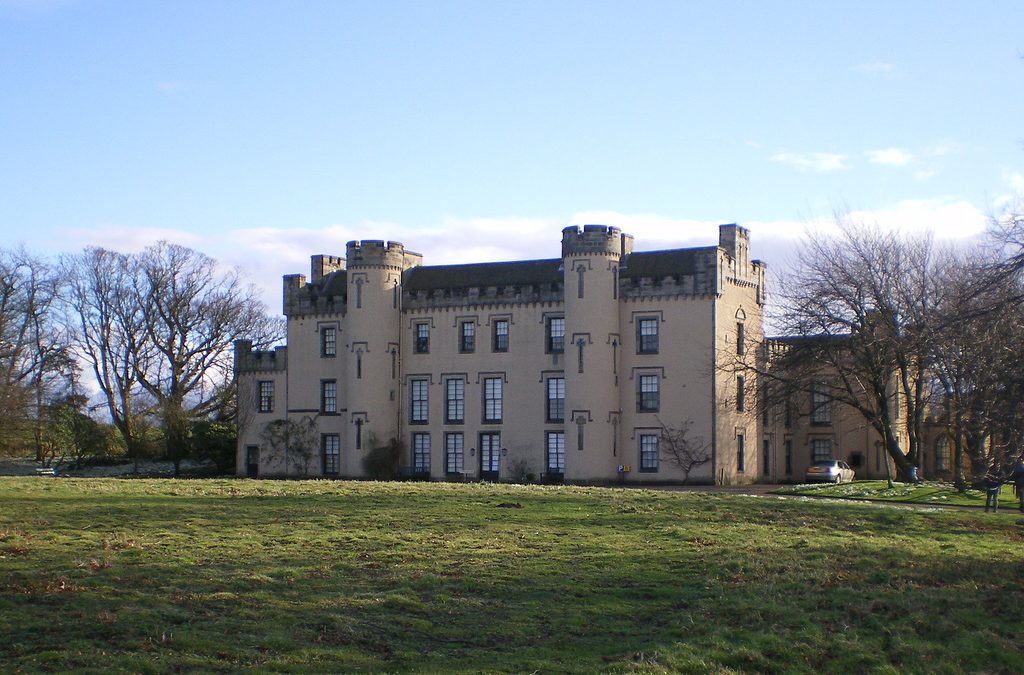The House of the Bins is located in a bustling urban area and stands out among the traditional brick and mortar buildings that surround it. The building is made up of several stacked shipping containers that have been modified and transformed into modern living spaces. The containers are arranged in a way that maximises the use of space and provides residents with stunning views of the city. The building also features a rooftop garden and communal areas where residents can socialise and interact with one another.
History of House of the Bins
Thomas Dalyell and the Dalyell Family
The House of the Bins is a historic building located in the town of Linlithgow, West Lothian, Scotland. The house was built in the early 17th century by Thomas Dalyell, a wealthy merchant and member of the Dalyell family. The Dalyell family was a prominent Scottish family with a long and storied history dating back to the 13th century.
General Tam Dalyell and the Royal Scots Greys
Kathleen Dalyell and the Dalyell Legacy
Another important member of the Dalyell family was Kathleen Dalyell, who was a noted philanthropist and social reformer during the early 20th century. Kathleen Dalyell was instrumental in the establishment of several important charities and social programs, and her legacy continues to be felt in Scotland to this day.
The House and Estate
Architecture and Restoration
The House of the Binns is a historic mansion located in West Lothian, Scotland. Built in the early 17th century, the house is a fine example of Scottish Baronial architecture. Over the years, the house underwent several renovations and restorations to preserve its original structure and features.
The Binns Tower and Pictish Fort
The Binns Tower is a prominent feature of the House of the Binns estate. The tower dates back to the 15th century and is believed to have been built as a defensive structure to protect the estate from invading forces.
The Binns Tower is also located on the site of a Pictish fort, which dates back to the 6th century. The fort was strategically placed on a hilltop, providing a clear view of the surrounding area.
The Woodland and Parkland
The House of the Binns estate is surrounded by beautiful woodland and parkland. The woodland garden is home to a variety of trees, including oak, beech, and birch. The parkland is home to a herd of fallow deer, which can often be seen grazing in the fields.
Visitors can explore the woodland and parkland on foot, following the woodland walk and parkland trail. The woodland walk takes visitors through the heart of the estate, while the parkland trail provides stunning views of the surrounding countryside.
The Walled Garden
The Walled Garden is home to a range of fruit and vegetables, including apples, pears, strawberries, and raspberries. Visitors can also see a variety of colourful flowers, including roses, dahlias, and lilies.
The Collection
House of the Bins boasts an impressive collection of furniture, artefacts, portraits, family mementos, china, porcelain, and silver. Each item in the collection has been carefully curated and sourced from various parts of the world.
Furniture and Artefacts
The furniture collection at House of the Bins is a testament to the exquisite taste of the owners. From antique chairs to ornate tables, each piece has been selected for its unique beauty and historical significance. The artefacts collection is equally impressive, with items ranging from ancient pottery to intricate carvings.
Portraits and Family Mementos
China and Porcelain
The china and porcelain collection at House of the Bins is a sight to behold. The delicate pieces have been sourced from all over the world and include rare and valuable items. From intricately painted plates to delicate tea sets, each item in the collection is a work of art.
Visiting the House of the Bins
Tours and Activities
The House of the Bins offers a range of tours and activities suitable for all ages. Visitors can choose from guided tours, audio tours, or self-guided tours of the house. The guided tours are led by experienced tour guides who will take you through the history of the house and its unique architecture. The audio tours are available in several languages and provide an immersive experience with interesting facts and stories about the house. Visitors can also participate in a peacock treasure hunt, which is a fun activity for families with young children.
Location Information and Parking
Facilities and Cleanliness
The House of the Bins is well-maintained, and the facilities are clean and modern. The house is equipped with all the necessary amenities, including restrooms, a gift shop, and a café. The staff is friendly and knowledgeable, and they are always available to assist visitors with any questions or concerns they may have. The house is also wheelchair accessible, and there are facilities for visitors with disabilities.
In conclusion, visiting the House of the Bins is a unique and memorable experience. The tours and activities are informative and engaging, and the facilities are clean and modern. The location is easily accessible, and there are several parking spaces available nearby. Visitors can enjoy a circular walk around the house, and participate in a peacock treasure hunt. The House of the Bins is a must-visit destination for anyone interested in history and architecture.
Conservation and Restoration Works
Roof Works and Repairs
In recent years, the House of the Bins has undergone extensive conservation and restoration works to ensure the preservation of the building’s historic features. One of the most significant areas of work has been the restoration of the roof. The National Trust, which owns the property, commissioned a team of specialist contractors to carry out the repairs.
The work involved replacing damaged tiles and repairing the lead flashing. The contractors also carried out a thorough inspection of the roof timbers, replacing any that were rotten or damaged. The result is a roof that is not only structurally sound but also looks as it did when it was first built.
Redecoration
As part of the restoration works, the interior of the House of the Bins has been redecorated to reflect its 17th-century origins. The National Trust worked with a team of expert decorators to recreate the original colour scheme and decorative features.
The team used traditional techniques and materials to achieve an authentic finish. The walls were painted with lime wash, and the woodwork was painted with a mixture of linseed oil and pigment. The result is a stunning interior that transports visitors back in time.
17th Century Plasterwork
Another area of focus for the restoration works was the 17th-century plasterwork. The National Trust commissioned a team of specialist plasterers to repair and restore the ornate plasterwork that adorns many of the rooms in the House of the Bins.
The plasterers used traditional techniques and materials to repair any damage and recreate missing sections. The result is a stunning example of 17th-century craftsmanship that has been preserved for future generations to enjoy.
Reviews and Latest News
Detailed Reviews and Ratings
House of the Binns is a stunning 17th-century mansion located in Linlithgow, Scotland. Visitors have praised the property’s beautiful architecture, well-maintained gardens, and informative guided tours. The National Trust for Scotland has received high ratings for their knowledgeable staff and excellent visitor experience.
One reviewer on TripAdvisor commented: “The House of the Binns is a fantastic place to visit. The guided tour was informative and entertaining, and the staff were friendly and helpful. The gardens are well worth exploring, and the views from the top of the hill are breathtaking.”
Another reviewer on Google said: “The House of the Binns is a hidden gem. The house is stunning, and the gardens are beautiful. The staff were knowledgeable and friendly, and the guided tour was excellent. I highly recommend a visit to this amazing property.”
Latest News from the National Trust for Scotland Website
The National Trust for Scotland has recently announced that they will be hosting a series of events at the House of the Binns this summer. These events include guided tours, garden walks, and outdoor theatre performances. Visitors can also enjoy a variety of family-friendly activities, including storytelling and craft workshops.
In addition to these events, the National Trust for Scotland has also announced that they will be launching a new exhibition at the House of the Binns. The exhibition will showcase the history of the property and its former owners, giving visitors a unique insight into the lives of the people who lived there.
Visitors are advised to check the National Trust for Scotland website for the latest information on events and exhibitions at the House of the Binns.
Surrounding Area
Hopetoun House and Mannerston
House of the Bin is located in a beautiful area surrounded by many historic houses and landmarks. Hopetoun House and Mannerston are two such places that are definitely worth a visit. Hopetoun House is a grand historic house located just a few miles away from House of the Bin. It was built in the 17th century and is still owned by the same family, the Hope family. Mannerston, on the other hand, is a more modest house that was built in the 18th century. It is known for its beautiful gardens and is a great place to visit if you are interested in horticulture.
Firth of Forth and Fife
Another great attraction in the surrounding area of House of the Bin is the Firth of Forth and Fife. The Firth of Forth is a large estuary located on the east coast of Scotland. It is a beautiful place to visit and offers panoramic views of the surrounding area. Fife, on the other hand, is a historic county located just across the Firth of Forth. It is known for its beautiful coastline, charming towns, and historic sites.
Edinburgh and West Lothian
Edinburgh is the capital city of Scotland and is located just a short drive away from House of the Bin. It is known for its historic architecture, beautiful parks, and rich cultural heritage. West Lothian is another great destination in the surrounding area. It is home to many historic sites, including Blackness Castle, which was built in the 15th century and was once used as a royal castle by King James VI.
Blackness Castle
Blackness Castle is a historic castle located in West Lothian. It was built in the 15th century and was once used as a royal castle by King James VI. It is now managed by Historic Environment Scotland and is open to the public. Visitors can explore the castle and learn about its history, including its use as a military fortress by the Royal Regiment of Scots Dragoons. The castle is also known for its beautiful surroundings, including Sergeant’s Pond and the snowdrops that bloom in the spring. It is a great place to visit for photography enthusiasts and history buffs alike.

